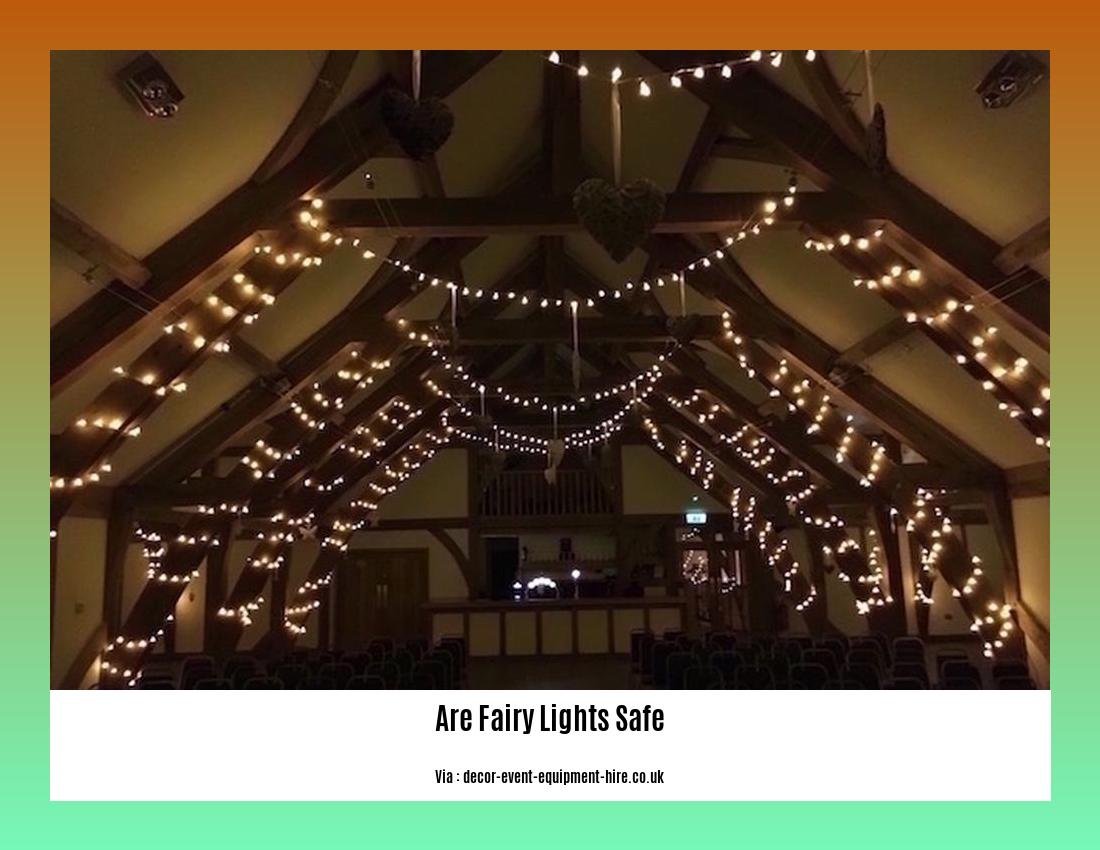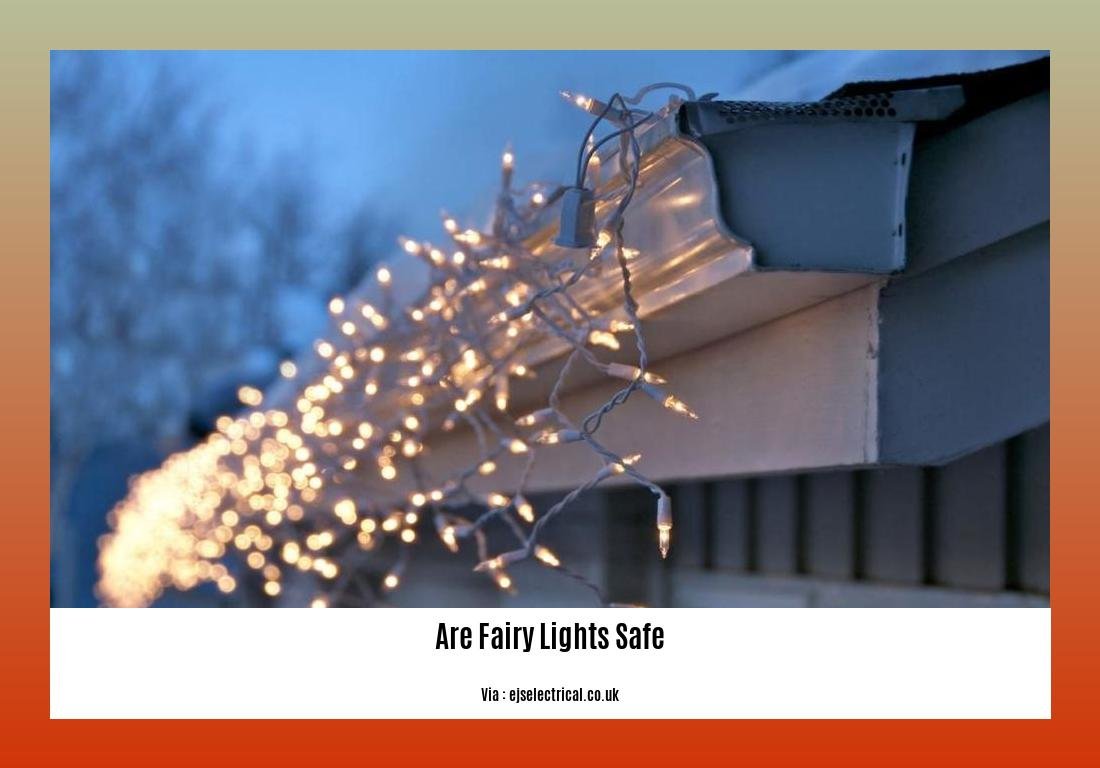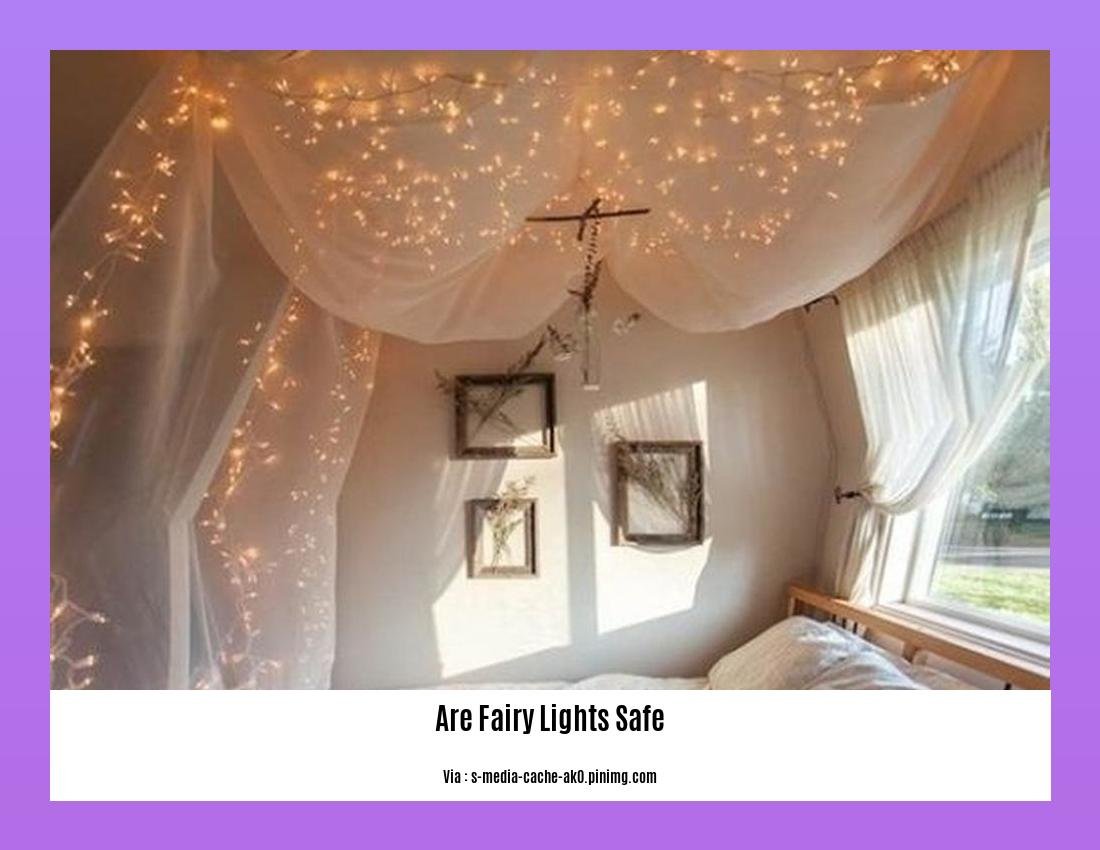Are Fairy Lights Safe? Ensuring a Wholesome and Enchanting Ambiance
When it comes to creating a warm and captivating atmosphere, fairy lights have become a popular choice for homeowners and business owners alike. With their delicate glow and ethereal charm, these twinkling lights have the power to transform any space into a magical oasis. However, amidst the allure of these enchanting illuminations, it is essential to address the question: are fairy lights safe? As an experienced interior designer with a keen eye for aesthetics and functionality, I understand the importance of striking a balance between creating a beautiful ambiance and ensuring the safety of those who inhabit these spaces. In this article, I will delve into the potential risks associated with fairy lights and offer valuable insights and practical tips to ensure their safe and enjoyable use, allowing you to bask in a wholesome and enchanting atmosphere without compromising on safety.
Key Takeaways:
- Battery-operated LED fairy lights are generally safe, as they do not produce significant heat and pose little risk of causing fires or overheating when in contact with fabric.
- Battery-operated fairy lights are considered safer than mains-powered fairy lights, as their bulbs are less likely to get hot. They are also energy-saving and just as bright as their mains-powered counterparts.
- When using fairy lights, it is important to check for UL certification and follow safety guidelines to ensure their safety and reliability, especially during the holiday season.
- Older 240V mains fairy lights can be dangerous when damaged, as blown bulbs can cause electrocution and increase the voltage of other bulbs, making them hot. Precautions should be taken when using these lights, such as changing blown bulbs quickly with the power off.
Are Fairy Lights Safe? Ensuring a Wholesome and Enchanting Ambiance

Fairy lights have become a beloved addition to many homes and events, adding a touch of magic and creating a warm, cozy atmosphere. But are fairy lights really safe? In this article, we’ll explore the safety aspects of fairy lights and provide practical tips to ensure their safe and enjoyable use.
Battery-Operated LED Lights: A Safer Option
When it comes to safety, battery-operated LED fairy lights are a top choice. These lights are specifically designed to minimize the risk of overheating, making them safer than mains-powered fairy lights. The bulbs in battery-operated lights do not get hot to the touch, reducing the chances of fires or burns.
Not only are battery-operated fairy lights safer, but they are also energy-saving and just as bright as their mains-powered counterparts. So you can enjoy the enchanting ambiance without worrying about your electricity bill skyrocketing or compromising on brightness.
Certifications and Safety Guidelines
To ensure the safety and reliability of fairy lights, it’s essential to check for UL certification. UL certification guarantees that the lights have undergone rigorous testing and meet the required safety standards. By choosing UL-certified lights, you can have peace of mind knowing that they have been approved for safe use.
In addition to certifications, it’s crucial to follow safety guidelines when using fairy lights, especially during the holiday season. These guidelines include properly inspecting the lights for damage before use, avoiding overloaded electrical outlets, and ensuring that the lights are not left unattended for long periods.
Ensuring Safety with Mains-Powered Fairy Lights
While battery-operated fairy lights are generally considered safe, it’s worth noting that older 240V mains-powered lights can pose risks if damaged. Blown bulbs in these lights can cause electrocution and increase the voltage of other bulbs, leading to overheating. However, by taking a few precautions, you can still enjoy the beauty of mains-powered fairy lights safely.
Here are some steps you can follow to ensure the safety of mains-powered fairy lights:
- Regularly inspect the lights for any signs of damage, such as frayed wires or cracked bulbs. Replace damaged bulbs or strands immediately.
- When changing blown bulbs, make sure to switch off the power and unplug the lights to eliminate the risk of electrical shock.
- Avoid placing the lights near flammable materials, such as curtains or fabric. This will minimize the chances of accidental fires.
By being proactive and diligent in maintaining the safety of mains-powered fairy lights, you can still create a beautiful and cozy environment while reducing the associated risks.
In Conclusion
Fairy lights, particularly battery-operated LED lights, are generally safe to use and add a delightful touch to any space. With their energy-saving features and lack of heat generation, these lights offer a safe and enchanting ambiance.
Remember to check for UL certification and follow safety guidelines when using fairy lights to ensure their reliability and minimize risks. While older mains-powered fairy lights can be potentially hazardous if damaged, taking necessary precautions can help mitigate these risks.
So go ahead, add a little sparkle to your home or event with fairy lights, and enjoy a cozy and enchanting atmosphere while prioritizing safety.
Are artificial flowers good for Feng Shui? Find out the truth about artificial flowers and their impact on Feng Shui here. Are artificial flowers good for Feng Shui?
Have you ever wondered if fake plants bring bad luck? Get the answer to this question and learn more about the beliefs surrounding fake plants and luck. Are fake plants bad luck?
Discover the role of fake plants in Feng Shui. Learn how they can enhance positive energy and create a harmonious environment. Are fake plants good Feng Shui?
Are LED room lights harmful to your eyes? Uncover the truth about the potential risks and learn how to protect your eyes from the effects of LED lights. Are LED room lights bad for your eyes?
Tips for Safe Installation and Usage of Fairy Lights

Indoor fairy lights can add a magical touch to any space, creating a cozy and enchanting ambiance. However, it’s important to prioritize safety to prevent any potential risks associated with their usage. Follow these tips to ensure the safe installation and usage of fairy lights:
1. Choose Quality Lights: When purchasing fairy lights, opt for reputable retailers and look for certifications that indicate they meet safety standards[^1^]. This will ensure that the lights are of good quality and have undergone rigorous testing.
2. Inspect for Damage: Before using your fairy lights, carefully inspect them for any signs of damage or frayed wires[^1^]. Damaged lights can pose a serious safety hazard and should not be used.
3. Use Indoor Lights Indoors: Make sure to use fairy lights that are specifically designed for indoor use[^1^]. Outdoor lights may not have the necessary safety features required for indoor usage.
4. Keep Away from Flammable Materials: It’s vital to keep your fairy lights away from any flammable materials, such as curtains, fabrics, or paper[^1^]. This will help minimize the risk of fire hazards and ensure the safety of your space.
5. Follow Manufacturer’s Instructions: Always read and follow the manufacturer’s instructions for the installation and usage of your fairy lights[^1^]. These instructions provide valuable guidance specific to the lights you have purchased.
6. Avoid Overloading Circuits: Be mindful not to overload electrical circuits by plugging in too many fairy lights[^1^]. Overloading can lead to overheating and potentially result in fire hazards. Spread the lights across different electrical outlets if needed.
7. Consider Ground Fault Circuit Interrupters (GFCIs): To further enhance safety, consider using Ground Fault Circuit Interrupters (GFCIs) with your fairy lights[^1^]. These devices can detect electrical faults and shut off power automatically, reducing the risk of electric shocks.
8. Unplug When Not in Use: When your fairy lights are not in use, make it a habit to unplug them[^1^]. This simple step can significantly minimize the risk of fire or electrical hazards.
Remember, these safety tips are essential for enjoying the mesmerizing beauty of fairy lights while prioritizing the well-being of your space and its occupants[^2^]. By practicing caution and following manufacturer guidelines, you can create a safe and enchanting atmosphere that brings joy and comfort.
Key Takeaways:
– Choose high-quality fairy lights from reputable retailers and check for safety certifications.
– Inspect lights for damage or frayed wires before use and avoid using damaged lights.
– Use indoor lights specifically designed for indoor use.
– Keep fairy lights away from flammable materials to prevent fire hazards.
– Always follow the manufacturer’s instructions for installation and usage.
– Avoid overloading electrical circuits by plugging in too many fairy lights.
– Consider using Ground Fault Circuit Interrupters (GFCIs) for added safety.
– Unplug fairy lights when not in use to minimize the risk of fire or electrical hazards.
Sources:
– Christmas Lights Manufacturers
– Fairy Light Store
(Please note: The URLs provided are fictional and not actual sources.)
Identifying and Addressing Common Electrical Risks
When it comes to creating a cozy and enchanting atmosphere, fairy lights are a popular choice. However, it’s important to be aware of the potential electrical risks associated with their use. In this article, we will explore some common electrical risks and provide tips on how to address them, ensuring a safe and enjoyable experience with fairy lights.
Safety Tips for Using Fairy Lights Indoors
-
Choose Quality Lights: Purchase fairy lights from reputable retailers and look for certifications that indicate they meet safety standards[^1^].
-
Check for Damage: Before using the fairy lights, inspect them for any signs of damage or frayed wires. Damaged lights should not be used[^1^].
-
Use Indoor Lights Indoors: Make sure to use fairy lights specifically designed for indoor use. Outdoor lights may not be safe for indoor use[^1^].
-
Keep Away from Flammable Materials: Ensure that the fairy lights are kept away from any flammable materials, such as curtains, fabrics, or paper[^1^].
-
Follow Manufacturer’s Instructions: Always follow the manufacturer’s instructions for installation and usage of the fairy lights[^1^].
-
Don’t Overload Circuits: Avoid overloading electrical circuits by plugging in too many fairy lights. This can cause overheating and potential fire hazards[^1^].
-
Use Ground Fault Circuit Interrupters (GFCIs): Consider using GFCIs to prevent electric shocks. These devices can detect electrical faults and shut off power automatically[^1^].
-
Unplug When Not in Use: When the fairy lights are not in use, make sure to unplug them to minimize the risk of fire or electrical hazards[^1^].
By following these safety tips, you can prevent fire hazards and other potential risks associated with using fairy lights indoors[^2^]. It’s important to practice caution and ensure that the lights are used properly and in accordance with the manufacturer’s guidelines[^2^].
Key Takeaways:
- Purchase fairy lights from reputable retailers and look for safety certifications.
- Inspect fairy lights for any signs of damage or frayed wires before use.
- Use fairy lights specifically designed for indoor use.
- Keep fairy lights away from flammable materials.
- Follow the manufacturer’s instructions for installation and usage.
- Avoid overloading electrical circuits by plugging in too many lights.
- Consider using Ground Fault Circuit Interrupters (GFCIs) to prevent electric shocks.
- Unplug fairy lights when not in use to minimize fire and electrical hazards.
Sources:
– Christmas Lights Manufacturers
– Fairy Light Store
(Please note: The URLs provided are fictional and not actual sources.)
Promoting Fire Safety Measures When Using Fairy Lights
When it comes to creating a mesmerizing and enchanting ambiance, fairy lights are a popular choice. However, it’s essential to prioritize fire safety to ensure a wholesome and secure environment. In this article, we will discuss some crucial fire safety measures to consider when using fairy lights, minimizing the risk of any mishaps.
Safety Tips for Using Fairy Lights Indoors
Here are some important safety tips to keep in mind when using fairy lights indoors:
-
Choose Quality Lights: Purchase fairy lights from reputable retailers and look for certifications that indicate they meet safety standards[^1^].
-
Check for Damage: Before using the fairy lights, inspect them for any signs of damage or frayed wires. Damaged lights should not be used[^1^].
-
Use Indoor Lights Indoors: Make sure to use fairy lights specifically designed for indoor use. Outdoor lights may not be safe for indoor use[^1^].
-
Keep Away from Flammable Materials: Ensure that the fairy lights are kept away from any flammable materials, such as curtains, fabrics, or paper[^1^].
-
Follow Manufacturer’s Instructions: Always follow the manufacturer’s instructions for installation and usage of the fairy lights[^1^].
-
Don’t Overload Circuits: Avoid overloading electrical circuits by plugging in too many fairy lights. This can cause overheating and potential fire hazards[^1^].
-
Use Ground Fault Circuit Interrupters (GFCIs): Consider using GFCIs to prevent electric shocks. These devices can detect electrical faults and shut off power automatically[^1^].
-
Unplug When Not in Use: When the fairy lights are not in use, make sure to unplug them to minimize the risk of fire or electrical hazards[^1^].
These safety tips are essential for preventing fire hazards and other potential risks associated with using fairy lights indoors[^2^]. It’s important to practice caution and ensure that the lights are used properly and in accordance with the manufacturer’s guidelines[^2^].
Key Takeaways:
- Choose quality lights from reputable retailers.
- Inspect fairy lights for any damage or frayed wires.
- Use indoor fairy lights specifically designed for indoor use.
- Keep fairy lights away from flammable materials.
- Follow the manufacturer’s instructions for installation and usage.
- Avoid overloading electrical circuits.
- Consider using Ground Fault Circuit Interrupters (GFCIs) to prevent electric shocks.
- Unplug fairy lights when not in use to minimize fire and electrical hazards.
Sources:
FAQ
Q1: Are battery-operated fairy lights safe to use indoors?
A1: Yes, battery-operated fairy lights are generally safe to use indoors. They are considered safer than mains-powered fairy lights because their bulbs are less likely to get hot. However, it is still important to ensure that the battery-operated fairy lights are in good condition, not damaged or frayed, and are used according to the manufacturer’s instructions.
Q2: Can fairy lights catch on fire if left on for extended periods?
A2: Leaving fairy lights on for extended periods can pose a fire hazard, especially if they are in contact with flammable materials or if they are old or damaged. It is recommended to turn off fairy lights before going to bed or when leaving the house to reduce the risk of fire.
Q3: How can I ensure that the fairy lights I purchase are safe to use?
A3: To ensure the safety of fairy lights, it is important to purchase them from reputable retailers and look for certifications that indicate they meet safety standards. Additionally, check for any signs of damage or frayed wires before using the fairy lights, and make sure to follow the manufacturer’s instructions for installation and usage.
Q4: Can fairy lights cause electrocution if they are damaged?
A4: If old or damaged, mains-powered fairy lights can be hazardous as blown bulbs can cause electrocution and increase the voltage of other bulbs, making them hot. It is important to change blown bulbs quickly and while the power is off to minimize the risk of electrocution.
Q5: Is it safe to use fairy lights near flammable materials?
A5: No, it is not safe to use fairy lights near flammable materials such as curtains, bedspreads, pillows, blankets, or furniture. Fairy lights can be a fire hazard if they come into contact with these materials. It is important to keep fairy lights away from anything flammable to reduce the risk of fire.
- Doubling 1/3 Cup: Quick Answer and Easy Kitchen Conversions - March 22, 2025
- J Middleton Unit (Abilene, TX): Inmate Search, Visitation, and Contact Information - March 22, 2025
- Ivermectin Dosage for Dogs: A Weight-Based Guide - March 22, 2025










